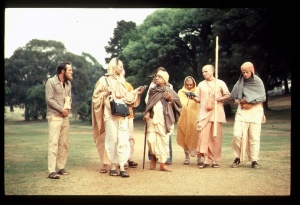SB 2.2.20

A.C. Bhaktivedanta Swami Prabhupada
TEXT 20
- nābhyāṁ sthitaṁ hṛdy adhiropya tasmād
- udāna-gatyorasi taṁ nayen muniḥ
- tato 'nusandhāya dhiyā manasvī
- sva-tālu-mūlaṁ śanakair nayeta
SYNONYMS
nābhyām — on the navel; sthitam — situated; hṛdi — in the heart; adhiropya — by placing; tasmāt — from there; udāna — soaring; gatya — force; urasi — on the chest; tam — thereafter; nayet — should draw; muniḥ — the meditative devotee; tataḥ — them; anusandhāya — just to search out; dhiyā — by intelligence; manasvī — the meditative; sva-tālu-mūlam — at the root of the palate; śanakaiḥ — slowly; nayeta — may be brought in.
TRANSLATION
The meditative devotee should slowly push up the life air from the navel to the heart, from there to the chest and from there to the root of the palate. He should search out the proper places with intelligence.
PURPORT
There are six circles of the movement of the life air, and the intelligent bhakti-yogī should search out these places with intelligence and in a meditative mood. Among these, mentioned above is the svādhiṣṭhāna-cakra, or the powerhouse of the life air, and above this, just below the abdomen and navel, is the maṇi-pūraka-cakra. When upper space is further searched out in the heart, one reaches the anāhata-cakra, and further up, when the life air is placed at the root of the palate, one reaches the viśuddhi-cakra.